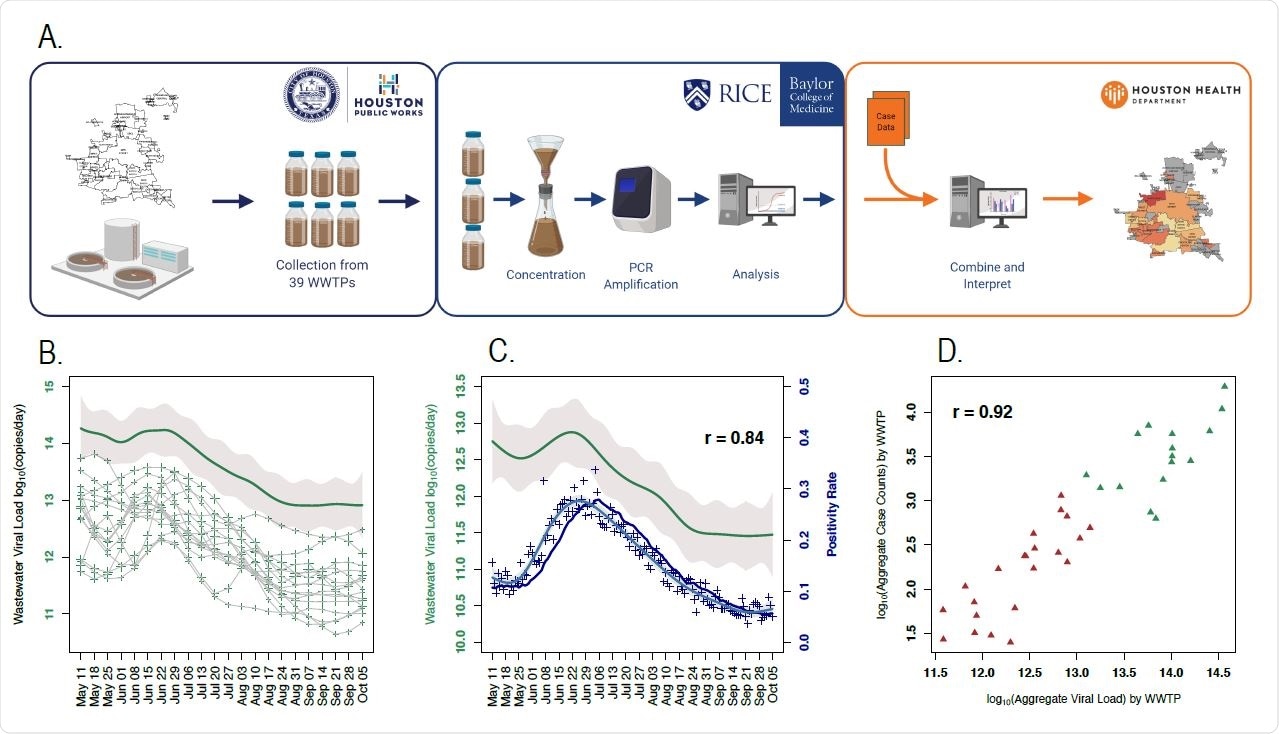With the skyrocketing cases of the coronavirus disease (COVID-19) across the globe, understanding the full extent of the pandemic is of paramount importance. However, it is an ongoing challenge for public health officials.
Currently, diagnostic testing capacity may be insufficient and, in some hospitals, the reporting of patients with COVID-19 lags for weeks. Also, many infected individuals do not develop symptoms, making it harder to identify who should be isolated and quarantined.
In past epidemics of viral diseases, scientists monitor sewage or wastewater for traces of a pathogen for effective surveillance of populations.

 *Important notice: medRxiv publishes preliminary scientific reports that are not peer-reviewed and, therefore, should not be regarded as conclusive, guide clinical practice/health-related behavior, or treated as established information.
*Important notice: medRxiv publishes preliminary scientific reports that are not peer-reviewed and, therefore, should not be regarded as conclusive, guide clinical practice/health-related behavior, or treated as established information.
Now, a team of researchers at Rice University, Baylor College of Medicine, and the Houston Health Department show SARS-CoV-2 RNA wastewater levels to be a strong predictive of trends in the nasal positivity rate two weeks in advance. This could help track the positivity rate for populations, speeding up the isolation and treatment of infected people.

Wastewater monitoring in Houston shows that SARS-536 CoV-2 levels track positivity rate. (A) Overview of weekly SARS-CoV-2 wastewater surveillance system. (B) A nonlinear regression (spline) was fit to the observations from each WWTP (+ symbols connected by lines represent the same WWTP; the size of the + denotes the level of uncertainty). The individual splines were inverse log10 transformed, summed, and then 1og10 transformed to form the overall spline (green line). Grey line is the 95% confidence band for the overall estimate derived from the sum of the variances (each spline). (C) Green line is the averaged spline for the wastewater viral levels for the 16 WWTPs (from panel B). Dark blue line is the 14-day moving average of the positivity rate (+ denoting the daily observations; the light blue line shows the nonlinear regression (spline) fit to those observations). Grey represents the 95% confidence bands. (D) Log10 total positive clinical cases against log10 total viral load over the study period. Symbols denote individual WWTP’s positive cases and total viral load. Green symbols denote wastewater viral loads and cases (May 11 - October 5) and red symbols sites between July 8 and October 5.
The study
Wastewater surveillance or monitoring for SARS-CoV-2 provides a way for the real-time tracking of community infection. Though COVID-19 is considered a respiratory disease, viral RNA can be detected in wastewaters because infected people also excrete SARS-CoV-2 in their stool.
Worldwide, SARS-CoV-2 RNA has been detected in many wastewater samples. Monitoring the sewage for SARS-CoV2 has many benefits, including being cost-effective, as a complementary tool to diagnostic testing, and it could identify outbreaks before diagnostic testing. Moreover, wastewater surveillance avoids biases of other epidemiological indicators and collects information from people who lack access to basic healthcare.
If the surveillance successfully reveals infection dynamics earlier than diagnostic testing, government and public health officials will have near-real-time data on disease prevalence.
To arrive at the study findings, published on the pre-print server medRxiv*, the researchers conducted a comprehensive wastewater monitoring program for the coronavirus in Houston, Texas, a city of 3.6 million people. The city experienced a surge in cases, hospitalizations, and deaths between May and October.
The team collected samples from 39 wastewater treatment plants in the city. They detected SARS-CoV-2 RNA levels in wastewater that provide a two-week warning for changes in the positivity rate.
From May to October, the team collected and analyzed 24-hour time-weighted composite influent samples from between 16 and 39 wastewater treatment plants once per week. The team collected these samples on the same day each week.
Study findings
The study findings showed that SARS-CoV-2 RNA wastewater levels were the strongest predictive indicator of trends in the positivity rate about two-weeks in advance.
“Given the strong predictive relationship of wastewater viral loads and positivity rates, wastewater monitoring represents a viable approach to test the entire population of Houston simultaneously, and a means to provide continuous, weekly monitoring of the entire population,” the researchers concluded in the study.
Also, wastewater viral RNA loads exhibited robust and potent tracking of the positivity rate for those served by individual treatment plants. These findings could be used in real-time to establish public health interventions.
The team noted that wastewater monitoring is a rapid and affordable approach to obtain comprehensive coverage of large populations. However, the researchers also believe that additional research is important to estimate disease prevalence from sewage water.
The team also recommends that the method be used not only in cities but also in the national and global community. This way, those areas where diagnostic testing is expensive and impossible could have the means to test for COVID-19 spread.
“After a vaccine is developed and administered, wastewater monitoring can facilitate early detection of re-emergence of SARS-CoV-2 in communities and be used to direct resources for vaccine administration, in line with previous work performed in the 1960s that facilitated the accelerated delivery of the oral polio vaccine to prevent outbreaks,” the researchers added.
The United States remains the nation with the highest case toll, reaching over 10 million cases. The death toll in the country surpassed 238,000. Globally, the number of cases topped 50.8 million and the number is expected to increase in the coming weeks as more countries are experiencing the second wave of the virus spread.

 *Important notice: medRxiv publishes preliminary scientific reports that are not peer-reviewed and, therefore, should not be regarded as conclusive, guide clinical practice/health-related behavior, or treated as established information.
*Important notice: medRxiv publishes preliminary scientific reports that are not peer-reviewed and, therefore, should not be regarded as conclusive, guide clinical practice/health-related behavior, or treated as established information.
Source:
Journal reference: